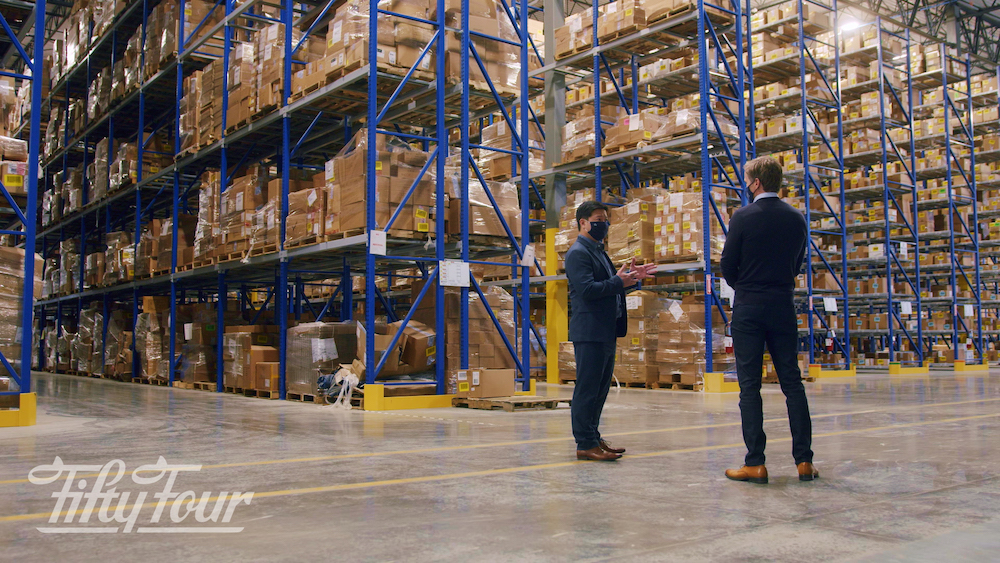
In the material handling and distribution center warehouse arena, we can divide our main tasks into three pieces of the pie: receiving, storing and shipping. In those pieces of pie lie a multitude of supporting functions that keep us on track and keep our operations running smoothly and profitably. If anything gets kinked up in the system, the ramifications can be felt throughout the structure – and have a negative effect on our efficiency and productivity, the two most important items in warehouse optimization.
Let’s dive a little deeper into the receiving piece of the pie. The dictionary defines receiving as being given something or presented with something. In its simplest form, receiving to the material handling and DC warehouse industry is a flow of goods and products into our warehouse. Making sure that flow remains orderly – and has the desired effect on the other two main functions – is paramount to having a smooth warehouse operation.
Material Handling and DC Warehouse Receiving Challenges
Receiving touches many parts of our material handling and DC warehouse systems and can have a positive – or negative effect – on any of them. Let’s take a look.
Inventory Issues
A large part of your inventory control depends on your warehouse receiving procedures and staff. Items coming in must be counted, inspected and added to the inventory. Failing to have the proper training for these procedures or unclear directions for all possible contingencies can easily lead to a bump in your inventory. If you look down the road (which all good managers do), you’ll see that a bump in the inventory could mean you’ve promised an item to a customer, only to find that you don’t actually have said item. Result: angry customer, bad reviews.
What happens if a shipment comes in with a majority of damaged pieces and your dock staff sticks the shipment to the side and fails to note it anywhere? In your warehouse management system (WMS), which tracks incoming products and counts your inventory in real time, someone has checked the box that the shipment arrived, but failed to take into account that none of it was shelved due to damaged boxes. Meanwhile, a customer service rep is promising a large delivery of those items to a customer who is planning a big event and depending on those items to arrive.
That’s not a pretty picture. It can lead to negative reviews and impacts on your business.
Storing Received Products in Your Warehouse
Another huge responsibility for the workers in your receiving department is to direct the freight to its proper place in the warehouse. Perhaps you are like a lot of us and have combined the job of unloading and accounting for shipments into the job of hopping on a forklift or using a utility vehicle to place product in its proper place. What happens if your system is flawed or your workers are not trained correctly? Product doesn’t go where it is supposed to go. The product is in your warehouse, so that’s a plus. If someone sells it to a customer, it’s at least there – somewhere.
Depending on the size of your warehouse and the size of your operations, your employees could spend needless hours traipsing around the building looking for the product. As in the above example, you surely don’t want to not have something you’ve already sold, but bringing it late is almost as bad.
Scheduling the Appropriate Number of Employees for Warehouse Receiving
A third aspect of receiving that doesn’t get mentioned as much is making sure the appropriate number of employees – and ones with that specialized training – are there when the truck arrives at your dock. If you ask one worker to do the job of several, chances are something is going to fall through the cracks. Having too many workers present can lead to you paying people to stand around.
In the past, scheduling employees was typically the function of a warehouse manager or possibly someone in the HR department. With many companies now outsourcing their HR department and the challenges we all face in the material handling and DC warehouse industry with having enough skilled labor, the job of making sure your bases are covered has become more complex.
Most of the issues we’ve talked about can be attributed to human error. And that’s just a fact of life. If you are completely dependent on humans to manage every aspect of your warehouse operation, there’s going to be mistakes. But let’s look at some of the ways you can turn this around and find what we like to call your warehouse Maximum Operating Potential, or your MaxOP.
Receiving Operations with Fewer Errors
Since a lot of the issues we’ve discussed can be attributed to human error, do you need some affordable automation in your material handling or DC warehouse? The great thing about the automation innovation in this industry is you can start small and gradually add to your system or you can jump feet first into a complete overhaul. The goal is to find a perfect ROI, which means getting a leg up on your competition so your business grows. With automation and other warehouse innovations, you’ll be able to:
- Focus on more important things like R&D, marketing and planning for the future
- Free up your key employees to devote their energies to their core strengths, leaving the menial and repetitive tasks to an automated system
- Eliminate the vast majority of issues plaguing your warehouse processes, including receiving errors
How does this work? Let’s take a quick look.

Automating Warehouse Receiving
A fully-functioning WMS can make short work of your receiving process and eliminate human error, except maybe if the forklift driver inadvertently dumps a pallet of fragile sculptures from Italy. Aside from that tragic event, your WMS can compare what’s listed on your warehouse receiving order (WRO) to what’s coming off the truck. Any discrepancies will be caught immediately and the shipment is put into an on-hold status until you respond to an email and resolve the situation. Your WMS does this for you so you don’t have to depend on an inventory clerk.
Of course, with a WMS, items that are meant to be on the shipment are counted correctly and dispatched to their proper place in the warehouse. There’s no guesswork or an overworked employee trying to keep count of a bunch of boxes.
Because your WMS is keeping track, you know in real time exactly what’s coming in (what you ordered or something else), how much you have and where it’s located. This can go a long way to eliminating the issues (and negative reviews) we described above with your customers.
A WMS can be used in conjunction with a fleet management system, as well as a labor management system. The benefits for your fleet are vast and include:
- Getting a clear picture of what equipment you are using appropriately and where changes can be made to optimize your operation.
- Understanding when a piece of equipment is due for its maintenance so you can reduce downtime and catch problems before they become major.
- Knowing where your equipment is at all times.
- Seeing if and when your equipment is being mistreated.
It’s similar with a labor management system. Your workers and your equipment are part of your resources – using them wisely increases your chances for optimization. A LMS can not only schedule your employees depending on the ebbs and flows of your warehouse cycles, but can give you an understanding of how best to assign and cover your warehouse functions.
In addition to exploring ways to automate your receiving processes, you can also see how that ties into making the rest of your warehousing run smoothly. At 54 Intralogistics, our specialty is helping you find your MaxOP. We have warehouse professionals located all over the U.S., ready to help you optimize and integrate your systems. Contact us for a free report to highlight how your distribution or fulfillment center can better manage your supply, production, receiving and distribution flow through superior intralogistics.
